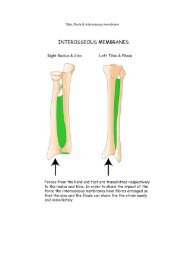GSM 11.11 version 6.2.0 - TTFN Smart card pages
GSM 11.11 version 6.2.0 - TTFN Smart card pages
GSM 11.11 version 6.2.0 - TTFN Smart card pages
- No tags were found...
Create successful ePaper yourself
Turn your PDF publications into a flip-book with our unique Google optimized e-Paper software.
(<strong>GSM</strong> <strong>11.11</strong> <strong>version</strong> <strong>6.2.0</strong> Release 1997)24TS 100 977 V<strong>6.2.0</strong> (1999-05)- backwards from the record preceding the one at which the record pointer is set (unless the record pointeris set to the first record).If an action following selection of a record is aborted, then the record pointer shall remain set at the record at which itwas set prior to the action.NOTE 1: It is not possible, at present, to have more than 255 records in a file of this type, and each record cannot begreater than 255 bytes.NOTE 2: This structure was previously referred to as "formatted" in <strong>GSM</strong>.6.4.3 Cyclic EFCyclic files are used for storing records in chronological order. When all records have been used for storage, then thenext storage of data shall overwrite the oldest information.An EF with a cyclic structure consists of a fixed number of records with the same (fixed) length. In this file structurethere is a link between the last record (n) and the first record. When the record pointer is set to the last record n, then thenext record is record 1. Similarly, when the record pointer is set to record 1, then the previous record is record n. Thelast updated record containing the newest data is record number 1, and the oldest data is held in record number n.HeaderBody Record 1Record 2::Record nFigure 6: Structure of a cyclic fileFor update operations only PREVIOUS record shall be used. For reading operations, the methods of addressing areNext, Previous, Current and Record Number.After selection of a cyclic file (for either operation), the record pointer shall address the record updated or increased last.If an action following selection of a record is aborted, then the record pointer shall remain set at the record at which itwas set prior to the action.NOTE:It is not possible, at present, to have more than 255 records in a file of this type, and each record cannot begreater than 255 bytes.6.5 Methods for selecting a fileAfter the Answer To Reset (ATR), the Master File (MF) is implicitly selected and becomes the Current Directory. Eachfile may then be selected by using the SELECT function in accordance with the following rules.Selecting a DF or the MF sets the Current Directory. After such a selection there is no current EF. Selecting an EF setsthe current EF and the Current Directory remains the DF or MF which is the parent of this EF. The current EF is alwaysa child of the Current Directory.Any application specific command shall only be operable if it is specific to the Current Directory.The following files may be selected from the last selected file:- any file which is an immediate child of the Current Directory;- any DF which is an immediate child of the parent of the current DF;- the parent of the Current Directory;- the current DF;- the MF.This means in particular that a DF shall be selected prior to the selection of any of its EFs. All selections are made usingthe file ID.ETSI








